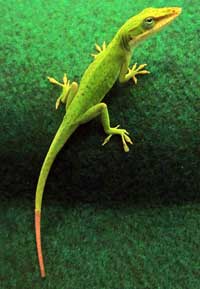Study of Anolis carolinensis tail regeneration shows loss of original tail function.
Lizards that can regenerate their tails once lost aren't exactly the same, according to a study published in The Anatomical Record. Researchers with Arizona State University and the University of Arizona studied regenerated tails of the green anole lizard (Anolis carolinensis) and found that the new tails are quite different from the original tails. The original tail has vertebrae and shorter muscle fibers. The new tails included a cartilaginous rod with pores and long muscle fibers that span the length of the new tail, characteristics not present in the original tail. The new tail also lacks nerves, which is of interest and the scientists speculate that nerves that are found in the original tail stump are grown into the new tail. The study suggests that the regenerated tail is less flexible and performs only some of the function of the original tail.
Scientists have been keenly interested in the capability of some lizards to regrow their tails, and believe that learning more about how lizards can regenerate their tails can be of benefit to humans in the future.
“Using next-generation technologies, we are close to unlocking the mystery of what genes are needed to regrow the lizard tail,” Kenro Kusumi, an associate professor in ASU’s School of Life Sciences in the College of Liberal Arts and Sciences, and co-author of the papers said in a press release put out by the university. “By supercharging these genes in human cells, it may be possible to regrow new muscle or spinal cord in the future.”



